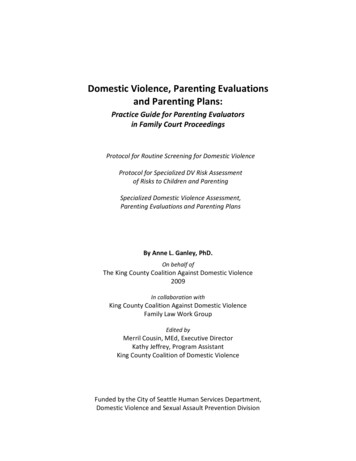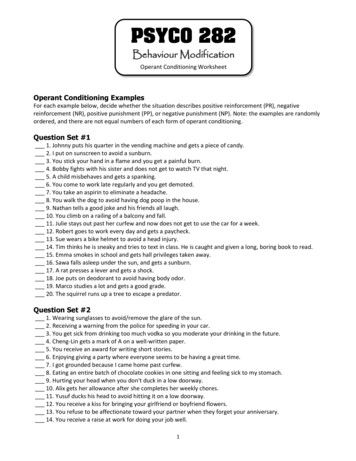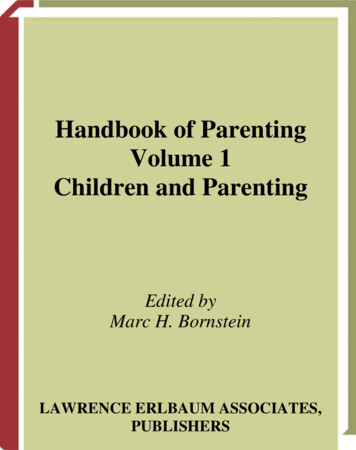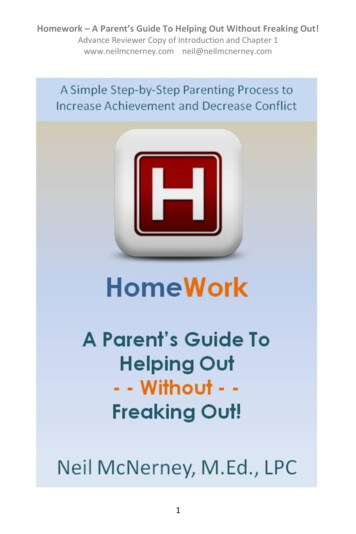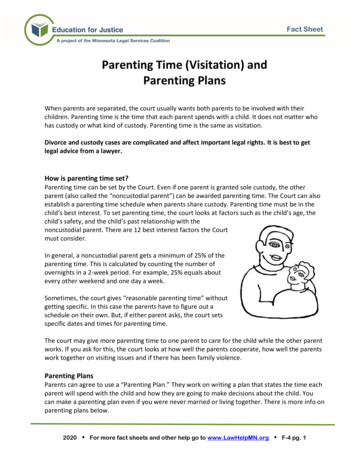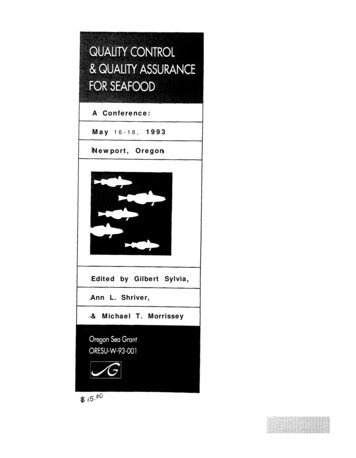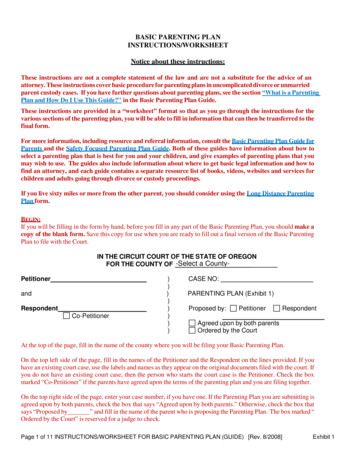
Transcription
BASIC PARENTING PLANINSTRUCTIONS/WORKSHEETNotice about these instructions:These instructions are not a complete statement of the law and are not a substitute for the advice of anattorney. These instructions cover basic procedure for parenting plans in uncomplicated divorce or unmarriedparent custody cases. If you have further questions about parenting plans, see the section “What is a ParentingPlan and How Do I Use This Guide?" in the Basic Parenting Plan Guide.These instructions are provided in a “worksheet” format so that as you go through the instructions for thevarious sections of the parenting plan, you will be able to fill in information that can then be transferred to thefinal form.For more information, including resource and referral information, consult the Basic Parenting Plan Guide forParents and the Safety Focused Parenting Plan Guide. Both of these guides have information about how toselect a parenting plan that is best for you and your children, and give examples of parenting plans that youmay wish to use. The guides also include information about where to get basic legal information and how tofind an attorney, and each guide contains a separate resource list of books, videos, websites and services forchildren and adults going through divorce or custody proceedings.If you live sixty miles or more from the other parent, you should consider using the Long Distance ParentingPlan form.BEGIN:If you will be filling in the form by hand, before you fill in any part of the Basic Parenting Plan, you should make acopy of the blank form. Save this copy for use when you are ready to fill out a final version of the Basic ParentingPlan to file with the Court.IN THE CIRCUIT COURT OF THE STATE OF OREGONFOR THE COUNTY OF -Select a CASE NO:PARENTING PLAN (Exhibit 1)Proposed by:PetitionerRespondentAgreed upon by both parentsOrdered by the CourtAt the top of the page, fill in the name of the county where you will be filing your Basic Parenting Plan.On the top left side of the page, fill in the names of the Petitioner and the Respondent on the lines provided. If youhave an existing court case, use the labels and names as they appear on the original documents filed with the court. Ifyou do not have an existing court case, then the person who starts the court case is the Petitioner. Check the boxmarked “Co-Petitioner” if the parents have agreed upon the terms of the parenting plan and you are filing together.On the top right side of the page, enter your case number, if you have one. If the Parenting Plan you are submitting isagreed upon by both parents, check the box that says “Agreed upon by both parents.” Otherwise, check the box thatsays “Proposed by” and fill in the name of the parent who is proposing the Parenting Plan. The box marked “Ordered by the Court” is reserved for a judge to check.Page 1 of 11 INSTRUCTIONS/WORKSHEET FOR BASIC PARENTING PLAN (GUIDE) [Rev. 8/2008]Exhibit 1
IMPORTANT NOTICE: The terms of your Parenting Plan will affect your legal rights andresponsibilities. You should consult the complete BASIC PARENTING PLAN GUIDEavailable at http://courts.oregon.gov/familylaw before filling out this form. You shouldconsult an attorney or your caseworker before filing your Parenting Plan with the court.1. GOALS FOR OUR CHILDRENThis plan is intended to ensure the children’s optimal development by providing continuity, stability andpredictability for the children, while ensuring frequent and continued contact with each parent. Because awritten plan cannot address every possible situation that might occur, the parents will implement this plan in aspirit of good faith and mutual cooperation. Parents are encouraged to re-evaluate this plan from time to timeas their children’s needs change.2. WHO OUR CHILDREN ARE (additional names are listed on an attached page)Write down the full legal name (do not use nickname), date of birth, age, and sex (male or female) of each child of thisrelationship. If you have more than four children, check the box, write their information on a separate page andattach it to your Parenting Plan form.Full NameDate of BirthCurrent ageSex (check one)M /FM /FM /FM /F3. WHAT THE WEEKLY SCHEDULE WILL BEIMPORTANT: Your decisions about how much time your children will spend in the care of each parentwill have important financial implications. This decision can affect how much child support a parent isresponsible for, whether a parent can claim a tax dependency deduction, etc. To check the percentageof parenting time your schedule gives each parent, go to https://justice.oregon.gov/calculator/parenting time/Parenting Time Schedule: Explain when your children will be in the care of each parent. You can use the blankcalendar in the Basic Parenting Plan Guide (BPPG) to help you work out your schedule. For questions andtips that may help you decide on a parenting time schedule, see the section “How Do I Get Started?” in the BPPG.For information about the needs of different-aged children, and for sample parenting time schedules, see the agespecific sections of “What’s Best for My Child?” in the BPPG. For books or other resources about creating aparenting time schedule, see “Where Can I Learn More?” in the BPPG.The parents acknowledge that they remain the children’s parents at all times. Each parent is responsible forproviding the children with a quality experience and for acting in the children’s best interests.3.1 For the purposes of describing the parenting time schedule, “Parent A” is the parent who the childrenstay with more than half the time, and “Parent B” is the parent who the children stay with less than half thetime. If the parenting time is exactly even, it does not matter who is assigned which letter. In this document:Parent A is (name)Parent B is (name)3.2 Weekday and Weekend Schedule:We will follow the schedule set forth belowPage 2 of 11 INSTRUCTIONS/WORKSHEET FOR BASIC PARENTING PLAN (GUIDE) [Rev. 8/2008]Exhibit 1
A. Parent A shall be responsible for the children’s care:Whenever the children are not scheduled to be with Parent B.On the following days and times:WEEKENDS:from (day)everyevery otherat:other (specify).m. to (day)WEEKDAYS: Specify day(s):atfrom::.m.m to:.mOTHER: (specify)B. Parent B shall be responsible for the children’s care on the following days and times:WEEKENDS:from (day)everyevery otherat :other (specify).m. to (day)WEEKDAYS: Specify day(s):atfrom::.m to.m:.mOTHER: (specify)Check the first box below if you want to describe a different parenting time schedule for any child. Check thesecond box below if you want to describe how the schedule will change over time as the children get older.You may complete and attach more than one Attachment 3.2(C) if needed.There is a different parenting time schedule for the following children in Attachment 3.2(C):(name)(name)(name)There will be a different parenting time schedule when the children reach a certain age, and it isdescribed in Attachment 3.2 (C).4. WHAT THE VACATION AND HOLIDAY SCHEDULE WILL BE4.1 Summer Schedule: (CHECK ONE) Check the first box if you want the schedule to stay the sameover the summer. Check the second box if you want the schedule to stay the same, except for vacation time.Check the third box if you want to follow a schedule during the summer that is different from the school year,and then describe the summer schedule in the space below.We will follow our weekday and weekend schedule during the summer. (SKIP TO 4.2)We will follow our weekday and weekend schedule during the summer, except that each parent shallhave the opportunity to spendweeks of uninterrupted vacation time with the children each summer.We will confirm our vacation schedules in writing by the end ofeach year. (SKIP TO 4.2)We will follow a different parenting time schedule during the summer:Parent A shall be responsible for the children’s careAt all times not specified in B below.On the following days and times:WEEKENDS:from (day)everyevery otherat :WEEKDAYS: Specify day(s):other (specify).m. to (day)atfrom:.m to::.m.mOTHER: (specify)Page 3 of 11 INSTRUCTIONS/WORKSHEET FOR BASIC PARENTING PLAN (GUIDE) [Rev. 8/2008]Exhibit 1
Parent B shall be responsible for the children’s care on the following days and times:WEEKENDS:from (day)everyevery otherat :other (specify).m. to (day)WEEKDAYS: Specify day(s):atfrom:.m to:.m:.mOTHER: (specify)4.2 School Breaks and Holiday Schedule: (CHECK ONE) Check the first box if you want to followyour weekday and weekend schedule during breaks and holidays, or if you want to work out specialarrangements for each break and holiday as it arises. This option means that if you can’t agree on specialarrangements, you follow your weekday and weekend schedule. Check the second box if you want to followa detailed holiday and school break schedule that you fill out below.We will follow our Weekday and Weekend Schedule for all holidays and school breaks. If we chooseto vary from the regular schedule for a holiday or break, we will follow the rules for temporary schedulechanges in paragraph 4.4 below. (SKIP TO 4.3)We will follow the Detailed Holiday Schedule below for any holiday or school break selected. If wewant to make special plans for a specific holiday, we have placed a check mark ( ) next to that holiday.For the holidays we check, this schedule overrides the weekday and weekend schedule above. If wehaven’t checked a holiday, we will follow the weekday and weekend schedule above.DETAILED HOLIDAY SCHEDULECHECK ONLY ONE BOX IN EACH COLUMN/ CHECK ONLY ONE BOX IN EACH COLUMN HOLIDAYSpring BreakParent A:Parent B:(same parent’s name as in paragraph 3.1)(same parent’s name as in paragraph 3.1)Begin day and time:Begin day and time:End day and time:End day and time:Every YearOdd YearsEven Years(For School Aged Children) First half ofthe school Spring Break.Every YearOdd YearsEven Years(For School Aged Children) Second halfof the school Spring Break.Other Plan:Mother’s DayOur children shall spend the day with Mother every Mother’s Day from 9 a.m. until 6 p.m.Other Plan:Page 4 of 11 INSTRUCTIONS/WORKSHEET FOR BASIC PARENTING PLAN (GUIDE) [Rev. 8/2008]Exhibit 1
HOLIDAYMemorialDay /WeekendParent A:(same parent’s name as in paragraph 3.1)Parent B:(same parent’s name as in paragraph 3.1)Begin day and time:Begin day and time:End day and time:End day and time:Every YearOdd YearsEven YearsEvery YearOdd YearsEven YearsOther Plan:Father’s DayOur children shall spend the day with Father every Father’s Day from 9 a.m. until 6 p.m.Other Plan:Fourth ofJulyBegin day and time:Begin day and time:End day and time:End day and time:Every YearOdd YearsEven YearsEvery YearOdd YearsEven YearsOther Plan:Labor Day /WeekendBegin day and time:Begin day and time:End day and time:End day and time:Every YearOdd YearsEven YearsEvery YearOdd YearsEven YearsOther Plan:ThanksgivingDay/ThanksgivingBreakBegin day and time:Begin day and time:End day and time:End day and time:Every YearOdd YearsEven YearsEvery YearOdd YearsEven YearsAge Specific Plan. If our children arein different age groups, we will follow theplan for theyoungest childoldestchild.Age Specific Plan. If our children arein different age groups, we will follow theplan for theyoungest childoldestchild.For children under age 3: From 9 a.m. until6 p.m. on Thanksgiving Day in even years.For children under age 3: From 9 a.m. until6 p.m. on Thanksgiving Day in odd years.For children age 3 and older: From 6 p.m.on Wednesday evening prior to Thanksgivinguntil 6 p.m. on the Sunday followingThanksgiving in even years.For children age 3 and older: From 6 p.m.on Wednesday evening prior to Thanksgivinguntil 6 p.m. on the Sunday followingThanksgiving in odd years.Other Plan:Page 5 of 11 INSTRUCTIONS/WORKSHEET FOR BASIC PARENTING PLAN (GUIDE) [Rev. 8/2008]Exhibit 1
HOLIDAYParent A:Parent B:(same parent’s name as in paragraph 3.1)(same parent’s name as in paragraph 3.1)Christmas/Begin day and time:Begin day and time:Winter BreakEnd day and time:End day and time:Every YearOdd YearsEven YearsEvery YearOdd YearsEven YearsAge Specific Plan. If our children are indifferent age groups, we will follow the planfor theyoungest childoldest child.Age Specific Plan. If our children are indifferent age groups, we will follow the planfor theyoungest childoldest child.For children under age 1: From 9 a.m. until6 p.m. on Dec. 24th in odd years and from 9a.m. until 6 p.m. on Dec. 25th in even years.For children under age 1: From 9 a.m. until6 p.m. on Dec. 24th in even years and from 9a.m. until 6 p.m. on Dec. 25th in odd years.For children between 12 months and 36months: From 6 p.m. on Dec. 24th. until 6p.m. on Dec. 25th in odd years and from 6p.m. on Dec. 25th. until 6 p.m. on Dec. 26th ineven years.For children between 12 months and 36months: From 6 p.m. on Dec. 24th. until 6p.m. on Dec. 25th in even years. From 6 p.m.on Dec. 25th. until 6 p.m. on Dec. 26th in oddyears.For children age 3 and older: From noonon the day after school ends until noon onDec. 26th in odd years and from noon on Dec26th until noon on the day before schoolresumes in even years.For children age 3 and older: From noonon the day after school ends until noon onDec. 26th in even years and from noon onDec 26th until noon on the day before schoolresumes in odd years.Other Plan:New Year’sEve/NewYear’s DayBegin day and time:Begin day and time:End day and time:End day and time:Every Year(odd/even isbased onNew Year’sDay)Children’sbirthdaysOdd YearsEven YearsEvery YearOdd YearsEven YearsOther Plan:Begin day and time:Begin day and time:End day and time:End day and time:Every YearOdd YearsEven YearsEvery YearOdd YearsEven YearsOther Plan:Page 6 of 11 INSTRUCTIONS/WORKSHEET FOR BASIC PARENTING PLAN (GUIDE) [Rev. 8/2008]Exhibit 1
HOLIDAYAll three-dayweekendsnot listedaboveParent A:Parent B:(same parent’s name as in paragraph 3.1)(same parent’s name as in paragraph 3.1)(Federal holidays, school in service days, etc.)If a parent has our children on a weekend with an unspecified holiday or non-school dayattached, the children shall be in that parent’s care for the holiday or non-school day.Other Plan:Other holidayor day ofsignificanceto the family:Begin day and time:Begin day and time:End day and time:End day and time:Every YearOdd YearsEven YearsEvery YearOdd YearsEven YearsOther Plan:Other holidayor day ofsignificanceto the family:Begin day and time:Begin day and time:End day and time:End day and time:Every YearOdd YearsEven YearsEvery YearOdd YearsEven YearsOther Plan:4.3 Primary Residence. (CHECK ONE)Parent A’s home shall be considered the “primary residence”.Neither parent’s home shall be considered the “primary residence”.4.4 Temporary Changes to Parenting Time. Temporary changes to the parenting time schedule may bemade at any time if both parents agree ahead of time. (CHECK ONE)The parents may agree verbally to any temporary changes in the parenting time schedule.The parents must agree on temporary changes to the parenting time schedule in writing.5. HOW WE WILL EXCHANGE OUR CHILDREN5.1 Timeliness. Parents will arrive withinminutes of the time they are scheduled to be with thechildren. If an unavoidable delay occurs, the delayed parent shall contact the other parent immediately.Page 7 of 11 INSTRUCTIONS/WORKSHEET FOR BASIC PARENTING PLAN (GUIDE) [Rev. 8/2008]Exhibit 1
5.2 Exchange Point/Transportation. Unless otherwise agreed by the parties, exchange of the childrenwill be: (CHECK ONE)The home of the parent who is beginning his or her time with the children. The parent who is endingtheir time with the children shall be responsible for dropping them off at the other parent’s home.Drop off at Parent A’s home shall be at thefront doorcurbsideother:.Drop off at Parent B’s home shall be at thefront doorcurbsideother:.A neutral place as follows:The parents shall share responsibility for bringing the children to and from the exchange point.Other:Additional provisions: (OPTIONAL—CHECK ALL THAT APPLY)If a parent starts his or her parenting time while the children are at school or in daycare, that parent shallpick the children up directly at the school or daycare. If the children are supposed to be at school or in daycare at the end of a parent’s scheduled parenting time, that parent shall drop the children off directly at theschool or daycare.If either parent is unable to provide transportation on a given occasion, he or she may designate one ofthe following individuals to do so:. These individuals are known to the children.Other:5.3 Clothing & Medication. The parents shall have the children ready with the clothing they need and anynecessary medications at the scheduled time of exchange. All clothing and medications that accompaniedthe children shall be returned with them to the other parent.6. HOW WE WILL MAKE DECISIONS ABOUT OUR CHILDRENIMPORTANT NOTICE: Your decision to select Joint or Sole Custody may have important legalconsequences. You are strongly encouraged to consult with an attorney regarding theseconsequences before making your final decision about Joint or Sole Custody.6.1 Day-to-Day Decisions. Each parent will make day-to-day decisions regarding the care and control ofour children during the time they are caring for our children. This includes any emergency decisionsaffecting the health or safety of our children.6.2 Major Decisions (Legal Custody). Major decisions include, but are not limited to, decisions about thechildren’s residence, education, non-emergency health care, and religious training. (CHECK ONE)Choose an arrangement for making “major decisions” including decisions about the children’s education,non-emergency health care, and religious training. If both parents will share in the responsibility for making“major decisions”, then check the box for Joint Custody. You can share responsibility in major decisionmaking even though the children are not in the care of each parent an equal amount of the time. If you willnot be sharing responsibility for major decisions, you need to decide which parent will have decision makingauthority, also called Sole Custody. You have the option to indicate whether the parent with Sole Custodywill be required to talk to the other parent prior to making some or all “major decisions”.Page 8 of 11 INSTRUCTIONS/WORKSHEET FOR BASIC PARENTING PLAN (GUIDE) [Rev. 8/2008]Exhibit 1
The parents have agreed to share in the responsibility for making major decisions about thechildren. This arrangement is known by the courts as Joint Custody.(parent’s name) shall make major decisions about the children. Thisarrangement is known by the courts as Sole Custody.(OPTIONAL)The custodial parent will consult (discuss) with the other parent:before making major decisions.before making major decisions on these specific issues:(OPTIONAL)The custodial parent will notify the other parent:before making major decisions.before making major decisions on these specific issues:Note: If this parenting plan is attached to a signed order or judgment of the court, the custodyprovisions in the plan should be consistent with what is in the judgment or order. In the eventof a conflict, the custody designation in the signed order or judgment shall prevail.6.3 Information Sharing. Unless there is a court order stating otherwise:Both parents have equal rights to inspect and receive the children’s school records, and both parents areencouraged to consult with school staff concerning the children’s welfare and education. Both parents areencouraged to participate in and attend the children’s school events.Both parents have equal rights to inspect and receive governmental agency and law enforcement recordsconcerning the children.Both parents have equal rights to consult with any person who may provide care or treatment for thechildren and to inspect and receive the children’s medical, dental and psychological records.Each parent has a continuing responsibility to provide a residential, mailing, or contact address and contacttelephone number to the other parent.Each parent has a continuing responsibility to immediately notify the other parent of any emergencycircumstances or substantial changes in the health of the children, including the children’s medical needs.7. HOW WE WILL COMMUNICATE ABOUT AND WITH OUR CHILDREN7.1 Parent and Child Communication.Both parents and children shall have the right to communicate by telephone, in writing or by e-mailingduring reasonable hours without interference or monitoring by the other parent.Rules for telephone, letters, e-mail or other parent and child communication: (DESCRIBE)Page 9 of 11 INSTRUCTIONS/WORKSHEET FOR BASIC PARENTING PLAN (GUIDE) [Rev. 8/2008]Exhibit 1
7.2 Parent to Parent Communication.Rules for telephone, letters, e-mail or other parent-to-parent communication: (DESCRIBE)8. FUTURE MOVES BY A PARENT. Unless there is a court order stating otherwise neither parent may moveto a residence more than 60 miles further away from the other parent without giving the other parentdays’ notice of the change of residence and providing a copy of such notice to the court.Additional rules about moving: (DESCRIBE)9. OTHER PROVISIONS ON HOW WE WILL WORK TOGETHER FOR OUR CHILDREN9.1 Children’s Activities. Children are often involved in activities other than school, such as sports,clubs, music, religious organizations, and social activities. Both parents are encouraged to take part innon-school activities with their children during their parenting time. Non-school activities should notunreasonably interfere with either parent’s schedule and parenting time. Non-school activities that mayaffect the other parent’s schedule: (CHECK ONE)Must be coordinated with the other parent.Will be planned to occur primarily during one parent’s scheduled parenting time.Other:9.2 Makeup and Missed Parenting Time.If a child is so ill that the child is unable to spend time with a parent, there will be no make-up ofparenting time unless the parents agree (CHECK ONE)in writingverballyIf a parent is unable to have the children during his or her scheduled parenting time for any reasons, therewill be no make-up of parenting time unless the parents agree: (CHECK ONE)in writingverbally9.3 Mutual Respect. The parents will not say things or knowingly allow others to say things in thepresence of the children that would take away the children’s love and respect for the other parent.9.4 Alternate Care. These are our ground rules for babysitters, day care providers, and other caregivers:(CHECK ALL THAT APPLY)We choose not to specify ground rules for alternate care.If a parent is unable to be with the children during scheduled parenting time, the other parent shallbe the first choice to provide of their care.Only the following people may provide alternate care:Page 10 of 11 INSTRUCTIONS/WORKSHEET FOR BASIC PARENTING PLAN (GUIDE) [Rev. 8/2008]Exhibit 1
The following people may not provide alternate care:Other:9.5 Other Items. (ADD ANY OTHER ITEMS YOU WOULD LIKE TO INCLUDE IN YOUR PLAN.)9.5 (a)Additional page attached (Attachment 9.5).10. PERMANENT CHANGES TO THE SCHEDULE. Permanent changes can be made only by applying to thecourt for a modification. One parent cannot change a court-ordered Parenting Plan on their own.11. DISPUTE RESOLUTION. We will try to work out any parenting plan disputes on our own. Only as alast resort will we resolve disputes through court action. (Local court rules will apply after filing a courtaction) Prior to filing any court action: (CHECK ONE)We will use a mutually agreed-upon, neutral third-party (such as a mediator, counselor, or otherprofessional) to resolve any parenting plan disputes before filing a court action about the parenting plan. Thisshall not apply in the event of an emergency or abusive circumstance.(OPTIONAL)For now, the following professional(s) will assist us, if available:A dispute resolution process shall not be required prior to filing a court action.12. SIGNATURES. My signature below indicates that I have read and agree with what has been decidedand written in this document.If the plan is proposed by only one parent, that parent alone should sign. If the plan is agreed to by both parents,both parents should sign. If you are filing this plan with the court, you should attach it to the appropriate legaldocument, such as a Petition or Judgment.(CHECK ONE)PetitionerSignatureCo-PetitionerDate(CHECK ONE)RespondentSignatureCo-PetitionerDatePage 11 of 11 INSTRUCTIONS/WORKSHEET FOR BASIC PARENTING PLAN (GUIDE) [Rev. 8/2008]Exhibit 1
children and adults going through divorce or custody proceedings. If you live sixty miles or more from the other parent, you should consider using the . Long Distance Parenting . Plan form. BEGIN: If you will be filling in the form by hand, before you fill in any part of the Basic Parenting Plan, you should make a copy of the blank form.

